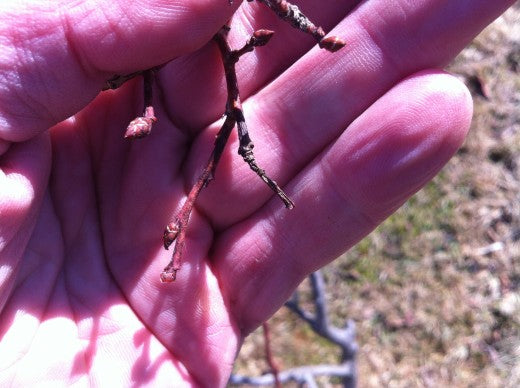Basic Blueberry Pruning Tips - By Doctor Joe

Blueberries are like my wife—kind, forgiving, and beautiful. Also like her, they require some attention to remain happy and healthy, yet are rather low maintenance. If you follow these basic tips, you won’t go too wrong with your blueberry bushes. These tips will not specifically help you with your relationship with your spouse or significant other, but routine attention and maintenance there would probably be helpful too.

Early Care Early on, you don’t have to do much pruning. In the first two years, just remove dead, diseased, or broken canes and branches. Sadly, the most important thing you can do in the first two years is to remove all the flowers! That’s right, you read correctly, take off all those beautiful fragrant flowers and bring them inside for your potpourri. Removing them will stimulate bush growth and vigor. Like disciplining your children, the pain precedes the joy of beautiful growth.

Some general comments here may be helpful. First year canes are smooth and colored, they harden off to a brown or gray after the first leaf-fall. Berries are borne on second year growth, so you want to try to always have some new growth being stimulated. The flower buds are the more plump or round buds near the tips of the branches; the narrow ones farther down the stems are the leaf buds. Pruning in the Spring is best, so that “winterkill” and deer-nibbled plant portions can be managed. The overall concepts are simple: keep the base narrow and free of clutter, open up the center of the bush, and obey my “ABCDE” mnemonic. -At the ground you want your stems in a fairly tight circle. This leaves less room for grass, weeds and trees to get a foothold; mulching here is okay, clutter is not.

Opening up the center means that the canopy should not be crowded. Air needs to circulate here, and sunlight needs to reach into the bush. You may need to remove some otherwise healthy stems to achieve this goal.
Doc’s Pruning Mnemonic: -A Aging -B Broken and Bad -C Crossed and Cozy -D Diseased and Dead -E “Eh” Let’s unpack the mnemonic. As the stems age, they take more energy to maintain, and therefore have less energy for fruit production. Stems over eight years old don’t produce a great deal. An easy rule of thumb is to consider removing stems that are greater than one inch in diameter.

Broken stems or branches, as well as any with “winterkill” should be removed. The winterkill looks just like what you would expect—an otherwise healthy bit of plant that just suddenly has an area that looks “frostbitten” and is black or dry. Prune back to the healthy looking portion. Crossing stems and branches should be minimized, as well as regions with too much crowding. Crossed stems rub and cause damaged areas that are more susceptible to diseases. (I am going to be mature here and refrain form any further humorous comments regarding the health hazards of inappropriate physical contact.) Areas that are too crowded tend not to get the air and sun needed to prosper, similar to living in New York City.

Some parts of the plants, and sometimes entire stems will just die; they need to be removed. Also remove anything that appears diseased. This may include mummified berries, shoots with fungi on them, or anything suspicious-looking for disease. If in doubt, cut it out. Better to start fresh with new growth, than to lose the whole plant to disease. And finally we come to the “Eh” category. This includes anything that just doesn’t impress you. Any non-vigorous, spindly, or weak canes or branches should be removed. It seems cruel, but there is no place for weaklings in the berry patch. Each stem and branch needs to “explain to you” its reason for being allowed to remain with the plant. If it can’t do that, then off to the burning pile with it!

A few last thoughts. If you have to prune out an entire stem, do so as close to the ground as possible. Leaving stubs above ground encourages them as an entry point for diseases. Also, I like to remove and burn my trimmings. There is some reason that those plant portions didn’t make the grade, and I don’t want them sitting at the base of my berry bush sharing the secrets of their failure with the surviving members of the family. For further excellent advice and some nice diagrams, etc., consider visiting www.fruit.cornell.edu. They have a plethora of information for small and large-scale fruit farming. Remember to enjoy yourself, listen to the birds, use your sunscreen when appropriate, and dream of large berries.
Doc Bio: Doctor Joe is a former US Army Captain, a rugged individualist, a practicing Medical Doctor and David's dear friend. He has a wonderful family and has cultivated a homestead in Upstate New York where he shares his blessings and bounty with friends and family.




Leave a comment